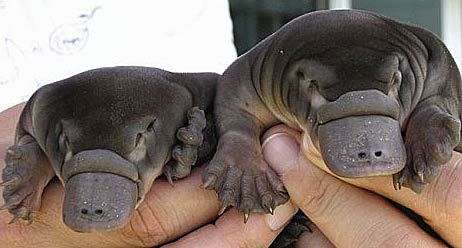Monotremes – Egg-laying Mammals

Baby Platypuses
The monotremes include the platypus and the spiny anteater or echnida of Australia and New Guinea. They lay a leathery egg much like that of reptiles, although after ten days, the young comes out of the egg and is then carried in a pouch. The females have mammary glands but no nipples, so the young must lap up the milk as it oozes from their skin. Monotremes have a number of other primitive reptilian features, such as a variable body temperature and a venomous claw in male platypuses. The platypus has a flexible “bill” like a duck, webbed feet, and a tail like a beaver, which it uses to swim in streams and catch freshwater insects and crayfish. The spiny anteater is covered with thick spines and lives on ants and termites, which it catches with its long, sticky tongue.
